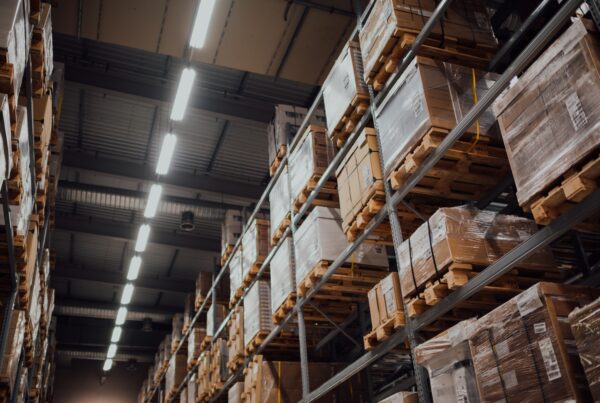Nowadays, customers not only expect a product or service when they make a purchase - they also pay for an experience. Positive experiences with the purchase process and the product/service therefore determine the level of customer satisfaction and strengthen customer loyalty. This is important because the customer base defines the success of the company.
An inefficient supply chain quickly leads to negative customer experiences and low customer satisfaction. The following issues related to supply chain performance could have a negative impact on customer satisfaction:
- Slower time to launch a new product
- Long delivery times
- Delays in replying to customer service requests
- Weak order processing
- Shortage of stock
- Poor product or service quality
Warehousing1 presents four supply chain factors below that could increase your company's customer satisfaction.
1 Use of Technology
Your company's supply chain can be improved by using automation in warehouse logistics. This makes operations in warehousing more efficient. Also, by automating logistics tracking processes, more insight into supply chain operations is possible for the customer. Warehouse management systems create even more benefits. In addition to the digital management of warehouse stocks, they also focus on upstream and downstream processes. They accelerate these, reduce the susceptibility to errors and thus increase efficiency. The use of modern warehouse management systems generally creates a high level of supply chain transparency, both on the customer side and within the company itself. Which new technologies can significantly improve a supply chain and have a positive impact on customer satisfaction is here .
Transparency and communication are important key competencies for a positive buying experience for your customers. Customer-facing strategies such as tracking or a digital information about product stocks can be seen as measures to increase customer satisfaction. In parallel, the company receives important data about the customers' demand behaviour, which in turn helps marketing for successful campaign planning.
2 Avoid out-of-stock
"The product is currently not available"? Then it will be bought from another shop. Even high customer loyalty rarely helps if the desired product is not available at your shop. Demands on availability and delivery times have changed extremely on the customer side. For retailers, this increasingly requires the existence of a widely distributed network of warehouse and fulfillment centers to guarantee fast delivery to the customer. Large inventories are not efficient in this context, as they not only entail high storage costs, but also the risk of getting stuck with the products and tying up capital in the long term.
The supply chain must be able to react flexibly and agilely to demand. Basically, it is difficult for retailers to find the optimal balance between excess and shortage. To avoid this, a modern supply chain should be able to regulate stocks in an agile manner. By using e.g. artificial intelligence, the supply chain adapts automatically. You can read here which new technologies can significantly improve a supply chain. At Warehousing1 we offer you the possibility to scale your rented storage space flexibly according to your needs and to build up a decentralized network of warehouses throughout Germany that you can manage centrally. In this way, out-of-stock can be avoided without increasing storage and capital costs.
3 Supplier Performance
The supply chain is only as strong as its weakest link. Suppliers therefore play a major role in determining supply chain performance. Since they are not under the direct control of their own company, a high degree of trust is necessary. But this can only be achieved if quality and performance are right. In order to minimize uncertainties in the supply chain, which could indirectly disrupt customer loyalty, it is essential to work closely with a small number of key suppliers. Close and trusting cooperation should ensure transparent and honest communication regarding supply and inventory bottlenecks. This transparency can then be passed on to the customer, which in turn increases customer satisfaction. The motto here should be that everyone pulls together. Because as Henry Ford said, "If everyone is moving forward together, then success takes care of itself".
4 Costs of the Supply Chain
In order to be able to keep the final price as low as possible for customers, the costs of the supply chain should be closely examined. Often these are responsible for a large proportion of the product price and must be passed on to customers in order not to completely lose the company's own margin.
However, caution should be taken when regulating costs. The optimal balance between reasonable and excessive supply chain cost reduction is very complex. Nobody is helped by cost pressure, which in the long term leads to liquidity bottlenecks on the supplier side. It is better to identify individual processes and activities in the supply chain that are inefficient or do not provide sustainable added value. Modern supply chains can use intelligent systems to identify unnecessary expenditures:
- Excessively high transport costs due to centralized storage with long transport routes
- Exorbitant costs in procurement
- High fixed costs in storage or transport if capacity utilisation is not fully used
- Inadequate inventory management
- Predictions regarding inventory and demand trends are not correct
Companies should review these factors in order to reduce costs for themselves (and ultimately for the customer). After all, the product price is ultimately an integral driver of customer satisfaction.
Warehousing1 is happy to support and advise you in order to increase the satisfaction of your customers. We work with the latest technologies and by using AI-based software we can identify a trustworthy warehouse service provider from over 300 warehouse locations and make customized offers. The intelligent selection of the optimal warehouse locations and processes as well as completely flexible billing models enable us to achieve strong savings potentials, which can increase costs by up to 50%. Even empty or overcrowded warehouses will no longer be a problem in the future. We would be happy to arrange an initial consultation today to increase your customer satisfaction!



